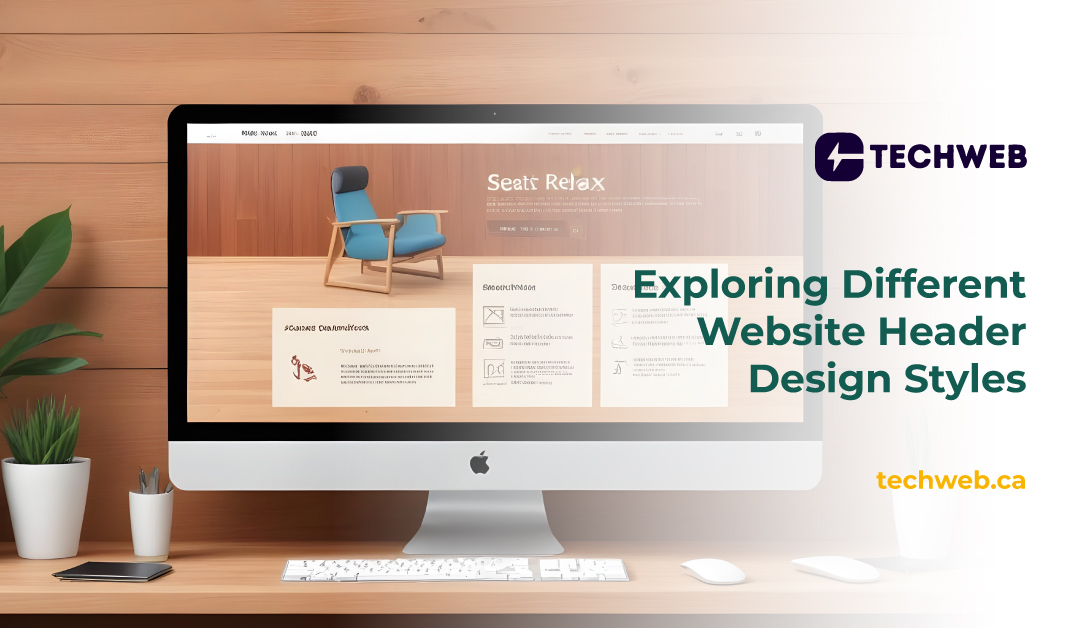Exploring Different Website Header Design Styles
When it comes to web design, the header is one of the most crucial elements on a page. It’s the first thing visitors see, and it sets the tone for the entire website experience. A well-designed header can enhance user engagement, improve navigation, and reinforce branding.

In this blog, we’ll explore different website header design styles, highlighting their unique features and the contexts in which they work best.
1. The Classic Horizontal Header
Overview: The horizontal header is the most traditional and widely used style. Typically positioned at the top of the page, it spans the entire width of the screen.
Key Features:
- Logo Placement: The logo is usually placed on the left side, helping with brand recognition.
- Navigation Menu: Main navigation links are arranged in a horizontal line, making them easy to find.
- Search Bar/Icons: Often, a search bar or key icons (like shopping carts or user profiles) are placed on the right side.
When to Use: This design works well for most websites, especially those with straightforward navigation needs. It’s familiar to users, making it a safe and reliable choice.
Examples: E-commerce sites, corporate websites, and news portals often use this style.
2. The Sticky Header
Overview: A sticky header remains fixed at the top of the screen as users scroll down the page. This ensures that key navigation elements are always within reach.
Key Features:
- Persistent Navigation: The navigation bar is always visible, providing quick access to important links.
- Adaptive Design: It can shrink or change style as users scroll to take up less space while still being functional.
- Enhances User Experience: By reducing the need to scroll back to the top, sticky headers improve user interaction and convenience.
When to Use: Ideal for content-heavy websites where users may need constant access to navigation options, such as blogs, long-form content sites, and online stores.
Examples: Blogs like Medium or news sites like The New York Times frequently use sticky headers.
3. The Full-Screen Header
Overview: The full-screen header takes up the entire viewport, creating a strong visual impact. It’s often used on homepages to grab attention right away.
Key Features:
- Bold Visuals: Often features large background images, videos, or dynamic content.
- Minimalist Navigation: Navigation links may be hidden or minimized to focus on the main message or call to action.
- Clear CTA: A prominent call-to-action (CTA) button is usually included, guiding users toward the next step.
When to Use: This style is perfect for landing pages, portfolio sites, or any website where you want to make a strong first impression.
Examples: Creative agencies, product launches, and personal portfolios often use full-screen headers to showcase their work or product.
4. The Split-Screen Header
Overview: The split-screen header divides the header area into two or more sections, usually with contrasting colors or images on each side.
Key Features:
- Dual Focus: This design allows you to highlight two distinct elements equally, such as two products, services, or brand messages.
- Visual Contrast: The split-screen layout creates a visually striking contrast that draws attention to both sides of the screen.
- Flexible Content: Each section can contain text, images, videos, or CTAs, depending on the design’s focus.
When to Use: Ideal for brands with multiple key offerings or when you want to showcase contrasting ideas or products.
Examples: Design studios, tech companies, or brands with a dual focus, like showcasing men’s and women’s fashion equally.
5. The Transparent Header
Overview: A transparent header allows the background content (such as an image or video) to show through, creating a seamless and elegant look.
Key Features:
- Blending Design: The header blends into the page, giving a clean and modern appearance.
- Dynamic Visuals: Often used with scrolling effects where the background image or video changes as the user scrolls.
- Sophisticated Appeal: Gives the website a sophisticated and premium feel, ideal for high-end brands.
When to Use: Best suited for websites with strong visual content, such as photography portfolios, luxury brands, or fashion sites.
Examples: Websites like Apple or fashion brands often use transparent headers to emphasize their high-quality visuals.
6. The Vertical Header
Overview: Unlike the more common horizontal layout, the vertical header runs down the side of the screen, usually on the left.
Key Features:
- Distinctive Layout: The vertical header offers a unique navigation experience that stands out from the crowd.
- More Space: It provides more room for navigation links, social media icons, and even descriptions without cluttering the page.
- Creative Flexibility: This layout allows for more creative design possibilities, making it a good choice for designers looking to break the mold.
When to Use: Ideal for websites that want to be distinctive or have a lot of navigation items. It’s also useful for sites where the main content needs to take center stage without the distraction of a top header.
Examples: Creative portfolios, design agencies, and boutique stores often use vertical headers to differentiate themselves.
Conclusion
Choosing the right header design style is essential to creating a cohesive and engaging user experience. Whether you’re going for a classic horizontal header or a bold full-screen design, the key is to align the header style with your brand’s needs and your audience’s expectations. Remember, the header is often the first impression your website makes—so make it count!
By understanding the different header design styles, you can make informed decisions that enhance your website’s functionality, aesthetics, and overall user experience.
